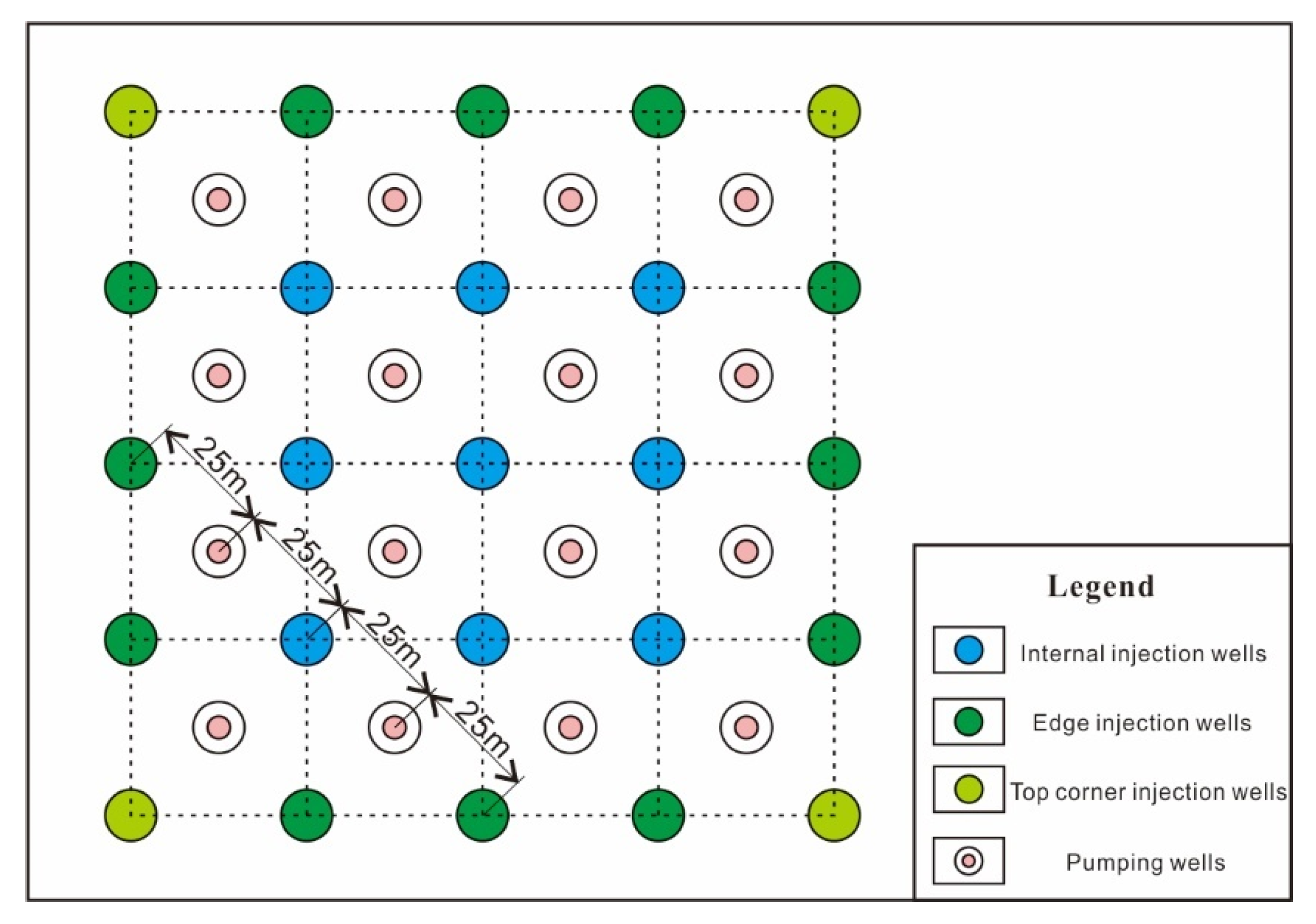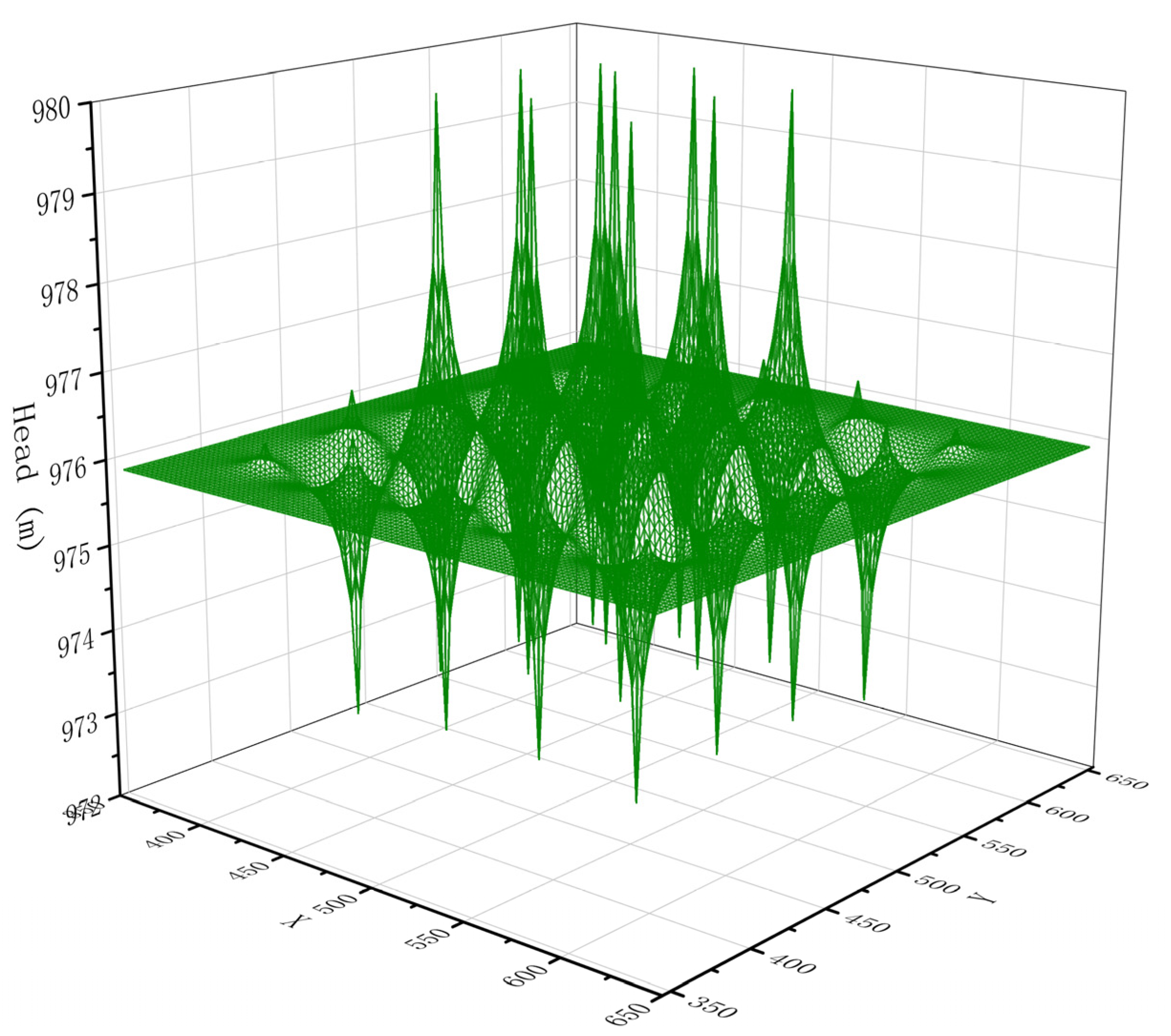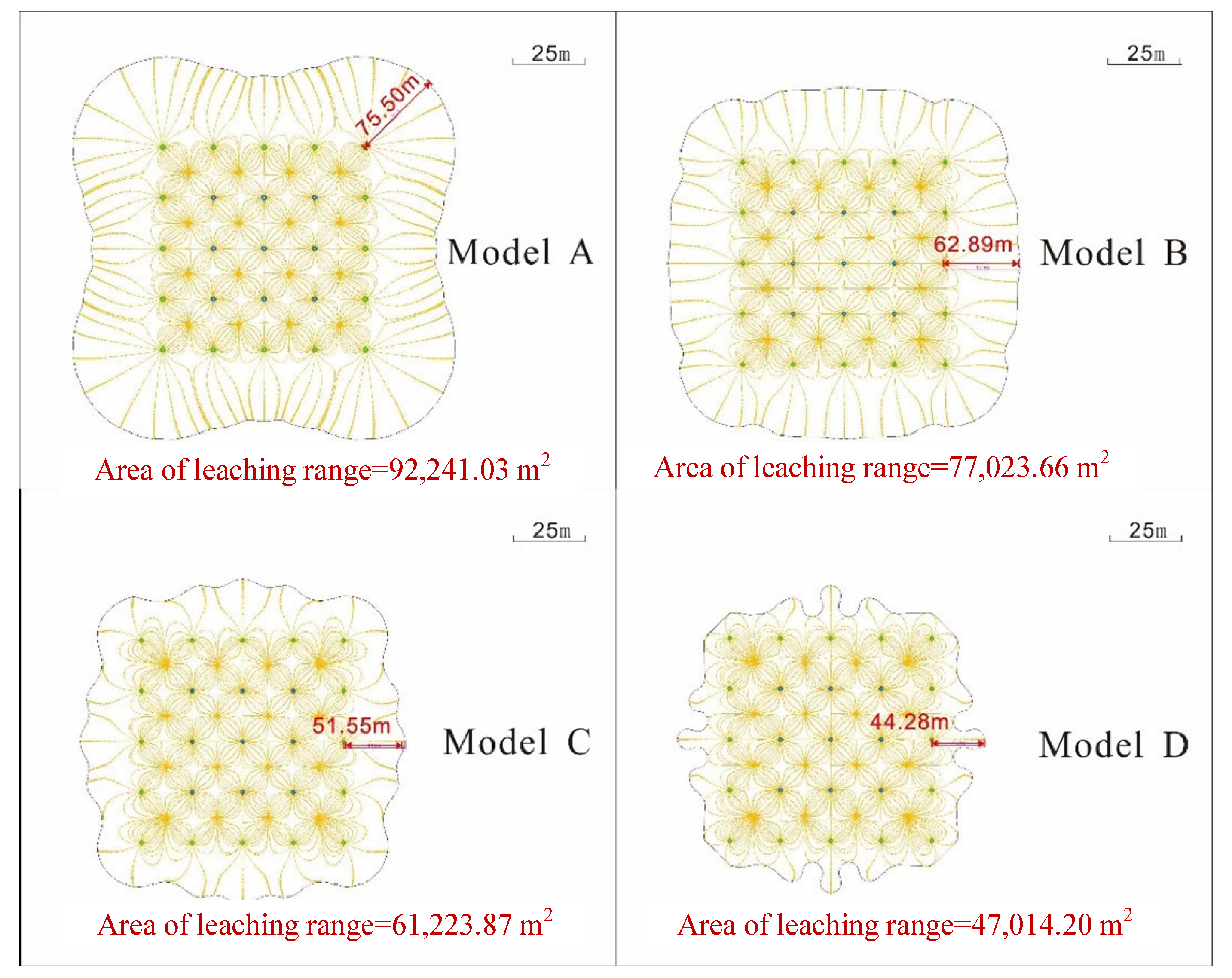Hydrodynamic Simulation of the Influence of Injection Flowrate Regulation on In-Situ Leaching Range
Abstract
:1. Introduction
2. Materials and Methods
3. Hydrodynamic Model of the Submerged Flow Field
3.1. Discussion on the Range of Leaching
3.2. Simulation Software and Numerical Methods
3.3. Model Generalization
3.3.1. Mock Object Overview
3.3.2. Stratigraphic Generalization and Boundary Conditions
3.3.3. Model Segmentation
4. Simulation Results and Discussion
4.1. Influence of Different Peripheral Low-Flow Liquid Injection Ratios on the Leaching Range
4.2. Trend Comparison
4.3. Verification
5. Conclusions
- (1)
- It is difficult to control the leaching range by adopting a complete infusion flowrate balance method, and specific control measures must be taken. That is to say, using a reasonable proportion to control the flowrate of the injection wells at different positions can significantly change the shape of the underground flow field and achieve effective control of the uranium leaching range in in-situ leaching mining.
- (2)
- The traditional method of setting the ratio of total extraction and infusion (total extraction > 0.3% of total injection) has a specific control effect, but has little effect on the leaching range.
- (3)
- This paper proposes a control method of peripheral small-flow liquid injection. Both field tests and numerical simulation studies show that this method has the most success in controlling the leaching range. In addition, compared with the traditional method of setting the ratio of total extraction and injection (total extraction > 0.3% of total injection), the process of this method is more straightforward, and the control effect is better.
Author Contributions
Funding
Data Availability Statement
Conflicts of Interest
References
- Jiang, Y.; Yao, Y.X.; Liao, W.S.; Li, X.J.; Liu, C.; Wang, L.M. Cause Analysis of Formation Damage during In-situ Leaching of Uranium. China Nuclear Society. In Proceedings of the 2009 Annual Meeting of China Nuclear Society, Beijing, China, 18 November 2009; pp. 752–762. [Google Scholar]
- Seredkin, M.; Zabolotsky, A.; Jeffress, G. In Situ Recovery, an Alternative to Conventional Methods of Mining: Exploration, Resource Estimation, Environmental Issues, Project Evaluation and Economics. Ore Geol. Rev. 2016, 79, 500–514. [Google Scholar] [CrossRef]
- Nguyen, V.V.; Pinder, G.F.; Gray, W.G.; Botha, J.F. Numerical simulation of uranium in-situ mining. Chem. Eng. Sci. 1983, 38, 1855–1862. [Google Scholar] [CrossRef]
- Tan, K.X.; Wang, Q.L.; Hu, E.M.; Zhou, Q. Multiple Processes Coupling and Reaction Front Propagation during In-situ Leach Mining: 1. Theoretical Analyses. Uranium Min. Metall. 2005, 24, 14–18. [Google Scholar]
- Omar, R.; Bruce, T.; José, M.C.; Rodriguez-Freire, L. Groundwater Restoration Following In-Situ Recovery (ISR) Mining of Uranium. Appl. Geo-Chem. 2019, 109, 104–408. [Google Scholar]
- Que, W.M.; Tan, Y.H.; Zeng, Y.J.; Wang, S.D. Geochemical Kinetics and Mass Transport of In-Situ Uranium Leaching; Atomic Energy Press: Beijing, China, 2002; pp. 43–44. [Google Scholar]
- Wang, H.F.; Su, X.B. Discussion of Push-pull Equilibrium in Well Field at Yining In-situ Leaching Mine, Xinjiang. Uranium Min. Metall. 1999, 18, 145–149. [Google Scholar]
- China National Nuclear Corporation. Code for Design of Uranium Mining and Metallurgy Engineering in Nuclear Industry; GB/T 50521-2009; Ji Hua Press: Beijing, China, 2010. [Google Scholar]
- Zhang, C.; Tan, K.X.; Xie, T.T.; Tan, Y.; Fu, L.; Gan, N.; Kong, L. Flow Microbalance Simulation of Pumping and Injection Unit in In Situ Leaching Uranium Mining Area. Processes 2021, 9, 1288. [Google Scholar] [CrossRef]
- Liu, Z.B.; Wang, H.F.; Wen, Z.Q.; Ding, Y.; Jiang, Y.; Xie, T.; Xu, G.; Wang, G. Study on the Characteristics of Solution Migration and Drawing and Injection Control at Well Field In-Situ Leaching Uranium. Uranium Min. Metall. 2017, 36, 23–26. [Google Scholar]
- Zhou, Y.P.; Shen, Z.L.; Sun, Z.X.; He, J.T.; Xing, Y.G. Study on the Influence of Pumping-injection Equilibrium on Outflow of Leaching Solution and Inflow of Groundwater during In-situ Leaching of Uranium. Nonferrous Met. (Min. Sect.) 2013, 65, 1–4. [Google Scholar]
- Mercer, J.W.; Faust, C.R.; Cohen, R.M.; Andersen, P.F.; Huyakorn, P.S. Remedial action assessment for hazardous waste sites via numerical simulation. Waste Manag. Res. 1985, 3, 377–387. [Google Scholar] [CrossRef]
- Hao, Y.; Liu, J.H.; Zhou, Y.P. Influence of In-situ Leaching on Groundwater around a Sandstone Type Uranium Mine in Xinjiang. Nonferrous Met. Eng. 2013, 3, 50–52. [Google Scholar]
- Ababou, R.; McLaughlin, D.; Gelhar, L.W.; Tompson, A.F. Numerical simulation of three-dimensional saturated flow in randomly heterogeneous porous media. Transp. Porous Media 1989, 4, 549–565. [Google Scholar] [CrossRef]
- Cao, Y.X.; Zuo, W.; Bao, Z.X.; Gu, P.; Ye, T. Practice and Exploring of Different Proportional Control of Drawing and Injection of Leaching Solution for the In-situ Leaching Uranium and Its Impact on the Groundwater Environment. Uranium Min. Metall. 2017, 36, 134–143. [Google Scholar]
- Grubb, S. Analytical model for estimation of steady-state capture zones of pumping wells in confined and unconfined aquifers. Groundwater 1993, 31, 27–32. [Google Scholar] [CrossRef]
- Ji, H.B.; Huang, Q.Y.; Zhou, Y.P.; Zhang, Q. Influence of In-situ Leaching Solution Diffusion with Drawing Injection flux Distribution and Drawing Injection proportion. Uranium Min. Metall. 2017, 36, 172–181. [Google Scholar]
- Xu, Q. Study on Influence of the Ratio of Drawing-injection to In-situ Leaching Solution Diffusion Range. Uranium Min. Metall. 2017, 36, 93–97. [Google Scholar]
- Gräsle, W.; Kessels, W.; Kümpel, H.J.; Li, X. Hydraulic observations from a 1 year fluid production test in the 4000 m deep KTB pilot borehole. Geofluids 2006, 6, 8–23. [Google Scholar] [CrossRef]
- Li, D.; Duan, B.S. Microscopic Equilibrium Optimization of Leaching Range in In-situ Leaching Mining Field. Uranium Min. Metall. 2017, 63, 279–283. [Google Scholar]
- Saghravani, S.R.; Mustapha, S.A.; Ibrahim, S.; Azwan, M.; Zawawi, M.; Randjbaran, E. Simulation of phosphorus movement in unconfined aquifer by means of visual MODFLOW. J. Comput. Sci. 2010, 6, 446. [Google Scholar]
- Li, M.J.; Lian, G.X.; Cao, F.B.; Yang, B. Study on Application of Non-uniform Drawing and Injection Flow Technology in Groundwater Protection during In-situ Leaching of Uranium. Uranium Min. Metall. 2017, 36, 98–104. [Google Scholar]
- Hudak, P.F. Groundwater modeling applied to production well management in a contaminated aquifer. Environ. Geol. 1994, 23, 119–124. [Google Scholar] [CrossRef]
- Chang, Y.X.; Tan, K.X.; Zhang, C.; Yao, Y.X.; He, C.Y.; Liu, Y. Simulation Study on Groundwater Dynamics Control of Leaching Range of In-situ Uranium Well Field. J. Univ. South China (Sci. Technol.) 2020, 36, 134–143. [Google Scholar]
- May, R.; Yusoff, I.; Tahir, W. Effects of Groundwater Withdrawal on the Interaction of Ex-mining Pond, River, and Aquifer. In Applied Mechanics and Materials; Trans Tech Publications Ltd.: Baech, Switzerland, 2014; Volume 567, pp. 38–43. [Google Scholar]
- Cheng, H. Calculation Method of Number of Pumping and Injection Holes in In-situ Leaching Well Field. China Nuclear Society. Progress Report on Nuclear Science and Technology in China (Volume V)—Proceedings of 2017 Annual Meeting of China Nuclear Society Volume 2 (Uranium Geology Sub Volume (2), Uranium Mining and Metallurgy Sub Volume). China Nucl. Soc. China Nucl. Soc. 2017, 4, 144–147. [Google Scholar]
- Solodov, I.N. The retardation and attenuation of liquid radioactive wastes due to the geochemical properties of the zone of injection. Geol. Soc. Lond. Spec. Publ. 1998, 128, 265–280. [Google Scholar] [CrossRef]
- Wang, X.W. Overview of In-situ Leaching of Uranium. Uranium Min. 1996, 1, 1–12. [Google Scholar]
- Wang, H.F. Technology and Practice of In-Situ Leaching of Uranium; Atomic Energy Press: Beijing, China, 1998; Volume 32, pp. 121–124. [Google Scholar]
- Lu, H.; Xu, Z.D.; Iseley, T.; Matthews, J.C. Novel data-driven framework for predicting residual strength of corroded pipelines. J. Pipeline Syst. Eng. 2021, 12, 04021045. [Google Scholar] [CrossRef]
- Chen, C.X.; Tang, Z.H. Numerical Method of Groundwater Flow; China University of Geosciences Press: Beijing, China, 1994; pp. 7–10. [Google Scholar]
- Wang, J.X. The Water Potential Description, Theoretical Models Study of Rainfall Infiltration and Application. Ph.D. Thesis, Tsinghua University, Beijing, China, 2010. [Google Scholar]
- Patrick, A.D.; Franklin, W.S. Physical and Chemical Hydrogeology; Wang, Y.X., Translator; High Education Press: Beijing, China, 2012; pp. 186–190. [Google Scholar]
- Chen, C.X.; Lin, M.; Cheng, J.M. Groundwater Dynamics; Geological Publishing House: Beijing, China, 2011; Volume 32, pp. 126–129. [Google Scholar]
- Zheng, C.M.; Gordon, D.B. Applied Contaminant Transport Modeling, 2nd ed.; Sun, J.Y.; Lu, G.P., Translators; High Education Press: Beijing, China, 2002; pp. 99–106. [Google Scholar]






| Model | Total Infusion Flow Ratio | Flow Ratio of Injection Wells at Different Positions | |
|---|---|---|---|
| Edge Orifice Flow/Internal Orifice Flow | Vertex Orifice Flow/Internal Orifice Flow | ||
| Model A | 0.003 | 1 | 1 |
| Model B | 0.003 | 1/2 | 1/4 |
| Model C | 0.003 | 1/4 | 1/8 |
| Model D | 0.003 | 1/6 | 1/12 |
| Model A1 | 0.000 | 1 | 1 |
| Model B1 | 0.000 | 1/2 | 1/4 |
| Model C1 | 0.000 | 1/4 | 1/8 |
| Model D1 | 0.000 | 1/6 | 1/12 |
| Drill Number | Injection Well Location | QA (m3/h) | QB (m3/h) | QC (m3/h) | QD (m3/h) | QA1 (m3/h) | QB1 (m3/h) | QC1 (m3/h) | QD1 (m3/h) |
|---|---|---|---|---|---|---|---|---|---|
| Z7 | Internal | 6.38 | 9.97 | 12.762 | 14.08 | 6.40 | 10.00 | 12.80 | 14.12 |
| Z8 | Internal | 6.38 | 9.97 | 12.762 | 14.08 | 6.40 | 10.00 | 12.80 | 14.12 |
| Z9 | Internal | 6.38 | 9.97 | 12.762 | 14.08 | 6.40 | 10.00 | 12.80 | 14.12 |
| Z12 | Internal | 6.38 | 9.97 | 12.762 | 14.08 | 6.40 | 10.00 | 12.80 | 14.12 |
| Z13 | Internal | 6.38 | 9.97 | 12.762 | 14.08 | 6.40 | 10.00 | 12.80 | 14.12 |
| Z14 | Internal | 6.38 | 9.97 | 12.762 | 14.08 | 6.40 | 10.00 | 12.80 | 14.12 |
| Z17 | Internal | 6.38 | 9.97 | 12.762 | 14.08 | 6.40 | 10.00 | 12.80 | 14.12 |
| Z18 | Internal | 6.38 | 9.97 | 12.762 | 14.08 | 6.40 | 10.00 | 12.80 | 14.12 |
| Z19 | Internal | 6.38 | 9.97 | 12.762 | 14.08 | 6.40 | 10.00 | 12.80 | 14.12 |
| Z2 | Edge | 6.38 | 4.99 | 3.190 | 2.35 | 6.40 | 5.00 | 3.20 | 2.35 |
| Z3 | Edge | 6.38 | 4.99 | 3.190 | 2.35 | 6.40 | 5.00 | 3.20 | 2.35 |
| Z4 | Edge | 6.38 | 4.99 | 3.190 | 2.35 | 6.40 | 5.00 | 3.20 | 2.35 |
| Z6 | Edge | 6.38 | 4.99 | 3.190 | 2.35 | 6.40 | 5.00 | 3.20 | 2.35 |
| Z10 | Edge | 6.38 | 4.99 | 3.190 | 2.35 | 6.40 | 5.00 | 3.20 | 2.35 |
| Z11 | Edge | 6.38 | 4.99 | 3.190 | 2.35 | 6.40 | 5.00 | 3.20 | 2.35 |
| Z15 | Edge | 6.38 | 4.99 | 3.190 | 2.35 | 6.40 | 5.00 | 3.20 | 2.35 |
| Z16 | Edge | 6.38 | 4.99 | 3.190 | 2.35 | 6.40 | 5.00 | 3.20 | 2.35 |
| Z20 | Edge | 6.38 | 4.99 | 3.190 | 2.35 | 6.40 | 5.00 | 3.20 | 2.35 |
| Z22 | Edge | 6.38 | 4.99 | 3.190 | 2.35 | 6.40 | 5.00 | 3.20 | 2.35 |
| Z23 | Edge | 6.38 | 4.99 | 3.190 | 2.35 | 6.40 | 5.00 | 3.20 | 2.35 |
| Z24 | Edge | 6.38 | 4.99 | 3.190 | 2.35 | 6.40 | 5.00 | 3.20 | 2.35 |
| Z1 | Top corner | 6.38 | 2.49 | 1.595 | 1.17 | 6.40 | 2.50 | 1.60 | 1.18 |
| Z5 | Top corner | 6.38 | 2.49 | 1.595 | 1.17 | 6.40 | 2.50 | 1.60 | 1.18 |
| Z21 | Top corner | 6.38 | 2.49 | 1.595 | 1.17 | 6.40 | 2.50 | 1.60 | 1.18 |
| Z25 | Top corner | 6.38 | 2.49 | 1.595 | 1.17 | 6.40 | 2.50 | 1.60 | 1.18 |
| Sampling Location | Sample Number | SO42− Concentration (mg/L) | δ34S (‰) |
|---|---|---|---|
| Inside the well-site | C1 | 23,047 | 0.4 |
| C2 | 17,447 | −0.4 | |
| C3 | 23,375 | 0.4 | |
| C4 | 26,875 | −0.5 | |
| C5 | 27,778 | −0.6 | |
| C6 | 28,760 | −0.2 | |
| C7 | 31,525 | −0.3 | |
| C8 | 39,203 | 1.0 | |
| C9 | 40,203 | 0.3 | |
| C10 | 36,453 | −0.3 | |
| Monitoring well outside the well-site | J1 | 194 | −11.1 |
| J2 | 210 | −8.2 | |
| J3 | 212 | −10.5 | |
| J4 | 237 | −9.7 | |
| J5 | 216 | −8.3 | |
| J6 | 141 | −6.9 |
Publisher’s Note: MDPI stays neutral with regard to jurisdictional claims in published maps and institutional affiliations. |
© 2022 by the authors. Licensee MDPI, Basel, Switzerland. This article is an open access article distributed under the terms and conditions of the Creative Commons Attribution (CC BY) license (https://creativecommons.org/licenses/by/4.0/).
Share and Cite
Zhang, C.; Xie, T.; Tan, K.; Yao, Y.; Wang, Y.; Li, C.; Li, Y.; Zhang, Y.; Wang, H. Hydrodynamic Simulation of the Influence of Injection Flowrate Regulation on In-Situ Leaching Range. Minerals 2022, 12, 787. https://doi.org/10.3390/min12070787
Zhang C, Xie T, Tan K, Yao Y, Wang Y, Li C, Li Y, Zhang Y, Wang H. Hydrodynamic Simulation of the Influence of Injection Flowrate Regulation on In-Situ Leaching Range. Minerals. 2022; 12(7):787. https://doi.org/10.3390/min12070787
Chicago/Turabian StyleZhang, Chong, Tingting Xie, Kaixuan Tan, Yixuan Yao, Yaan Wang, Chunguang Li, Yongmei Li, Ying Zhang, and Hui Wang. 2022. "Hydrodynamic Simulation of the Influence of Injection Flowrate Regulation on In-Situ Leaching Range" Minerals 12, no. 7: 787. https://doi.org/10.3390/min12070787
APA StyleZhang, C., Xie, T., Tan, K., Yao, Y., Wang, Y., Li, C., Li, Y., Zhang, Y., & Wang, H. (2022). Hydrodynamic Simulation of the Influence of Injection Flowrate Regulation on In-Situ Leaching Range. Minerals, 12(7), 787. https://doi.org/10.3390/min12070787






